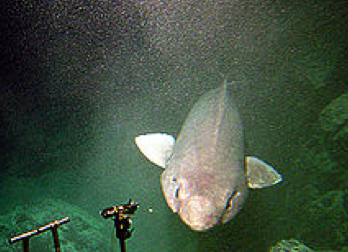The sluggish bathydemersal false catshark, shown here at a depth of 1,200 meters, has an enormous oil-filled liver which lets it hover off the continental slope at near-neutral buoyancy. It feeds on cephalopods,cutthroat eels, grenadiers, snake mackerel, and lanternsharks.
Benthopelagic fish inhabit the water just above the bottom, feeding on benthos and zooplankton. Most demersal fish are benthopelagic.
Deep sea benthopelagic teleosts all have swim bladders. The dominant species, rattails and cusk eels, have considerable biomass. Other species include deep sea cods (morids), deep sea eels, halosaurs and notacanths.
Benthopelagic sharks, like the deep sea squaloid sharks, achieve neutral buoyancy with the use of largeoil-filled livers. Sharks adapt well to fairly high pressures. They can often be found on slopes down to about 2000 metres, scavenging on food falls such as dead whales. However, the energy demands of sharks are high, since they need to swim constantly and maintain a large amount of oil for buoyancy. These energy needs cannot be met in the extreme oligotrophic conditions that occur at great depths.
Shallow water stingrays are benthic, and can lie on the bottom because of their negative buoyancy. |
 |
Deep sea stingrays are benthopelagic, and like the squaloids have very large livers which give them neutral buoyancy.
Benthopelagic fish can be divided into flabby or robust body types. Flabby benthopelagic fishes are likebathypelagic fishes; they have a reduced body mass, and low metabolic rates, expending minimal energy as they lie and wait to ambush prey. An example of a flabby fish is the cusk-eel Acanthonus armatus, a predator with a huge head and a body that is 90 percent water.
This fish has the largest ears (otoliths) and the smallest brain in relation to its body size of all known vertebrates.
Deepwater benthopelagic fish are robust, muscular swimmers that actively cruise the bottom searching for prey. They often live around features, such as seamounts, which have strong currents. Commercial examples are the orange roughy and Patagonian toothfish. |

